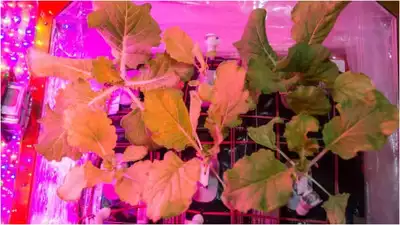Chinese astronauts aboard the Shenzhou 16 have successfully grown fresh vegetables on the Tiangong space station, part of China’s plans for future deep space exploration.
Mission commander Jing Haipeng and astronauts Zhu Yangzhu and Gui Haichao cultivated lettuce starting in June, harvesting four batches. In August, they grew cherry tomatoes and green onions.
The Shenzhou-16 mission is China’s fifth manned flight to its station since 2021. It advances the country’s ambitious space program. The crew will return to Earth on October 31 and hand the station to the new Shenzhou 17 astronauts.
Researchers on Earth grew matching crops to compare results and understand the differences between growing plants in space versus on the ground. This supports long-term deep space exploration plans, they say.
Researcher Yang Renze said vegetable farming is key for the station’s Environmental Control and Life Support System. Growing plants verifies relevant technologies and will focus on large-scale, rapid cultivation.
“The system can enable crewed lunar and Mars missions,” Yang said. “Plants absorb carbon dioxide and generate oxygen through photosynthesis, regenerating and purifying water.”
China aims to land astronauts on the moon before 2030 and build a moon base within the next decade. A future crewed Mars landing is also a goal for Chinese spaceflight.
FAQs about Chinese Astronauts Harvest Tomatoes, Lettuce In Space
What vegetables did the Shenzhou-16 astronauts grow?
The Shenzhou-16 astronauts cultivated four batches of lettuce starting in June. In August, they grew cherry tomatoes and green onions on the Tiangong space station as part of their vegetable farming experiments.
Why are the Chinese astronauts growing crops in space?
China is growing vegetables like lettuce, tomatoes, and onions in Tiangong to test technologies needed for future long-duration crewed missions to the Moon and Mars. The crops provide food, absorb CO2, generate oxygen, and recycle water.
How are space crops different from Earth crops?
Researchers on Earth are growing matching crops to study differences caused by microgravity. Results will help improve agricultural techniques for sustainable food production during deep space exploration.
What is China’s future vision for space exploration?
The Shenzhou-16 mission advances China’s ambitious goals, including landing astronauts on the Moon before 2030, building a lunar base within a decade, and eventually sending astronauts to Mars.
When will the Shenzhou-16 astronauts return to Earth?
After spending six months aboard Tiangong, the three astronauts of Shenzhou-16 will return to Earth on October 31, 2022. They will hand over the space station to the next Shenzhou-17 crew.
